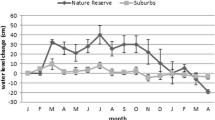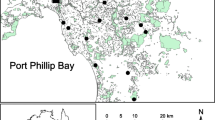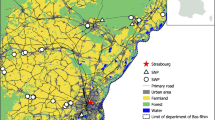Abstract
Understanding interactions between roadways and population structure and movements of wildlife is key to mitigating “road effects” associated with increasing urbanization of the landscape. Aquatic turtles are a useful focal group because (1) population persistence is sensitive to mortality of individuals upon roads; (2) turtles frequently move among wetlands and encounter roads, and (3) turtles are an important component of vertebrate biomass in aquatic ecosystems. From 2005 to 2007, we examined the effects of urbanization on local- and landscape-scale populations of turtles. To do so, we sampled and marked turtles in 15 ponds arranged along a steep, urban–rural gradient in central New York State. We captured 494 turtles, representing 327 individuals, the majority of which were common snapping turtles Chelydra serpentina (n = 191) and eastern painted turtles Chrysemys picta picta (n = 122). At the local population (pond) scale, a higher proportion of female snapping turtles in ponds was associated with lower road densities within 500 m of ponds. The mean size of both species of turtle increased in ponds with a lower density of roads within 100 m. At the landscape-level, we observed fewer turtles dispersing through urbanized habitat than forested, and fewer movements through areas with a higher density of roads. Our study suggests that roads alter both local- and landscape-level turtle populations through a loss of female turtles, and by reducing movement between ponds. By extension, the study targets key landscape features upon which to focus mitigation efforts.


Similar content being viewed by others
References
Aresco MJ (2005a) The effect of sex-specific terrestrial movements and roads on the sex ratio of freshwater turtles. Biol Conserv 123:37–44
Aresco MJ (2005b) Mitigation measures to reduce highway mortality of turtles and other herpetofauna at a north Florida lake. J Wildl Manage 69:549–560
Ashley EP, Robinson JT (1996) Road mortality of amphibians, reptiles and other wildlife on the Long Point Causeway, Lake Erie, Ontario. Can Field-Nat 110:403–412
Baldwin EA, Marchand MN, Litvaitis JA (2004) Terrestrial habitat use by nesting painted turtles in landscapes with different levels of fragmentation. North East Nat 11:41–48
Bodie JR, Semlitsch RD (2000) Spatial and temporal use of floodplain habitats by lentic and lotic species of aquatic turtles. Oecologia 122:138–146
Bonier F, Martin PR, Wingfield JC (2007) Urban birds have broader environmental tolerance. Biol Lett 3:670–673
Bowne DR, Bowers MA, Hines JE (2006) Connectivity in an agricultural landscape as reflected by interpond movements of a freshwater turtle. Conserv Biol 20:780–791
Brown GP, Brooks RJ (1994) Characteristics of and fidelity to hibernacula in a northern population of snapping turtles, Chelydra serpentina. Copeia 1994:222–226
Christens E, Bider JR (1987) Nesting activity and hatching success of the painted turtle (Chrysemys picta marginata) in southwestern Quebec. Herpetologica 43:55–65
Congdon JD (1993) Delayed sexual maturity and demographics of Blanding’s turtles (Emydoidea blandingii): implications for conservation and management of long-lived organisms. Conserv Biol 7:826–833
Congdon JD, Gatten RE Jr (1989) Movements and energetics of nesting Chrysemys picta. Herpetologica 45:94–100
Congdon JD, Dunham AE, Van Loben Sels RC (1994) Demographics of common snapping turtles (Chelydra serpentina): implications for conservation and management of long-lived organisms. Am Zool 34:397–408
Crooks KR, Suarez AV, Bolger DT (2004) Avian assemblages along a gradient of urbanization in a highly fragmented landscape. Biol Conserv 115:451–462
deMaynadier PG, Hunter ML (2000) Road effects on amphibian movements in a forested landscape. Nat Areas J 20:56–65
Francois C, Alexandre L, Julliard R (2008) Effects of landscape urbanization on magpie occupancy dynamics in France. Landscape Ecol 23:527–538
Gagne SA, Fahrig L (2007) Effect of landscape context on anuran communities in breeding ponds in the National Capital Region, Canada. Landscape Ecol 22:205–215
Gibbons JW, Semlitsch RD, Greene JL, Schubauer JP (1981) Variation in age and size at maturity of the slider turtle (Pseudemys scripta). Am Nat 117:841–845
Gibbons JW, Greene JL, Congdon JD (1983) Drought-related responses of aquatic turtle populations. J Herpetol 17:242–246
Gibbs JP, Shriver WG (2002) Estimating the effects of road mortality on turtle populations. Conserv Biol 16:1647–1652
Gibbs JP, Steen DA (2005) Trends in sex ratios of turtles in the United States: implications of road mortality. Conserv Biol 19:552–556
Gibbs JP, Whiteleather KK, Schueler FW (2005) Changes in frog and toad populations over 30 years in New York State. Ecol Appl 15:1148–1157
Gibbs JP, Breisch AR, Ducey PK, Johnson G, Behler J, Bothner R (2007) The amphibians and reptiles of New York State: Identification, natural history, and conservation. Oxford University Press
Hanski I (1999) Metapopulation ecology, 1st edn. Oxford University Press, Oxford
Hanski I, Gilpin ME (1991) Metapopulation dynamics: brief history and conceptual domain. Biol J Linn Soc 42:3–16
Haxton T (2000) Road mortality of snapping turtle, Chelydra serpentina, in central Ontario during their nesting period. Can Field-Nat 114:106–110
Homer C, Huang C, Yang L, Wylie B, Coan M (2004) Development of a 2001 national land cover database for the United States. Photogramm Eng Remote Sensing 70:829–840
Houlahan JE, Findlay CS (2003) The effects of adjacent land use on wetland amphibian species richness and community composition. Can J Fish Aquat Sci 60:1078–1094
Iverson JB (1982) Biomass in turtle populations: a neglected subject. Oecologia 55:69–76
Joly P, Morand C, Cohas A (2003) Habitat fragmentation and amphibian conservation: building a tool for assessing landscape matrix connectivity. C R Biol 326:132–139
Joyal LA, McCollough M, Hunter ML (2001) Landscape ecology approaches to wetland species conservation: a case study of two turtle species in Southern Maine. Conserv Biol 15:1755–1762
Karraker NE (2007) Investigation of the amphibian decline phenomenon: novel small-scale factors and a large-scale overview. PhD. Thesis. State University of New York College of Environmental Science and Forestry, Syracuse, New York, USA, pp 1–172
Levins R (1969) Some demographic and genetic consequences of environmental heterogeneity for biological control. Bull Entomol Soc Am 12:237–240
Lode T (2000) Effect of a motorway on mortality and isolation of wildlife populations. Ambio 29:163–166
Marchand MN, Litvaitis JA (2004) Effects of habitat features and landscape composition on the population structure of a common aquatic turtle in a region undergoing rapid development. Conserv Biol 18:758–767
Mazerolle MJ (2006) Improving data analysis in herpetology: using Akaike’s Information Criterion (AIC) to assess the strength of biological hypotheses. Amphibia-Reptilia 27:169–180
McDonnell MJ, Pickett STA (1990) Ecosystem structure and function along urban–rural gradients: an unexploited opportunity for ecology. Ecology 71:1232–1237
NatureServe (2006) NatureServe explorer: an online encyclopedia of life [web addition], version 6.1. NatureServe, Arlington, Virginia. Available http://www.natureserve.org/explorer
Pettit KE, Bishop CA, Brooks RJ (1995) Home range and movements of the common snapping turtle, Chelydra serpentina, in a coastal wetland of Hamilton Harbour, Lake Ontario, Canada. Can Field-Nat 109:192–200
R Development Core Team (2006) R: a language and environment for statistical computing. R Foundation for Statistical Computing, Vienna, Austria
Ray N, Lehmann A, Joly P (2002) Modeling spatial distribution of amphibian populations: a GIS approach based on habitat matrix permeability. Biodivers Conserv 12:2143–2165
Ream C, Ream R (1966) The influence of sampling methods on the estimation of population structure in painted turtles. Am Midl Nat 75:325–338
Ricketts TH (2001) The matrix matters: effective isolation in fragmented landscapes. Am Nat 158:87–99
Rizkalla CE, Swihart RK (2006) Community structure and differential responses of aquatic turtles to agriculturally induced habitat fragmentation. Landscape Ecol 21:1361–1375
Rowe JW (2003) Activity and movements of midland painted turtles (Chrysemys picta marginata) living in a small marsh system on Beaver Island, Michigan. J Herpetol 37:342–353
Saumure RA, Bider JR (1998) Impacts of agricultural development on a population of wood turtles (Clemmys insculpta) in southern Quebec, Canada. Chelonian Conserv Biol 3:37–45
Savard J-PL, Clergeau P, Mennechez G (2000) Biodiversity concepts and urban ecosystems. Landscape Urban Plan 48:131–142
Smith LL, Dodd CK (2003) Wildlife mortality on U.S. highway 441 across Paynes Prairie, Alachua County, Florida. Fla Sci 66:128–140
Steen DA et al (2006) Relative vulnerability of female turtles to road mortality. Anim Conserv 9:269–273
Steyermark A, Finkler MS, Brooks RJ (eds) (2008) Biology of the snapping turtle (Chelydra serpentina). The John Hopkins University Press
Trombulak SC, Frissell CA (2000) Review of ecological effects of roads on terrestrial and aquatic communities. Conserv Biol 14:18–30
Ultsch GR (2006) The ecology of overwintering among turtles: where turtles overwinter and its consequences. Biol Rev 81:339–367
Vos CC, Chardon JP (1998) Effects of habitat fragmentation and road density on the distribution pattern of the moor frog Rana arvalis. J Appl Ecol 35:44–56
Welsh HH Jr, Ollivier LM (1998) Stream amphibians as indicators of ecosystem stress: a case study from California’s redwoods. Ecol Appl 8:1118–1132
Wilbur HM (1975) A growth model for the turtle Chrysemys picta. Copeia 1975:337–343
Acknowledgments
We would like to thank Brett Jesmer, Kevin Shoemaker, Alex Krofta, Oscar Pineda, and Casey Tompkins for their help in the field, and Viorel Popescu for advice on the use of GIS. The Radisson Community Association and Radisson Greens Golf Course in Baldwinsville generously provided access to field-sites and help with transporting field equipment. We would also like to thank the New York State Department of Environmental Conservation, particularly Gary Pratt) and New York State Department of Transportation (NSYDOT), particularly Debra Nelson, for their help and support. An earlier draft of this manuscript was greatly improved by suggestions from an anonymous reviewer. Funding for the study was provided by the NYSDOT contract C-04-02.
Author information
Authors and Affiliations
Corresponding author
Rights and permissions
About this article
Cite this article
Patrick, D.A., Gibbs, J.P. Population structure and movements of freshwater turtles across a road-density gradient. Landscape Ecol 25, 791–801 (2010). https://doi.org/10.1007/s10980-010-9459-0
Received:
Accepted:
Published:
Issue Date:
DOI: https://doi.org/10.1007/s10980-010-9459-0




